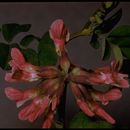en
names in breadcrumbs


Hosackia rosea, synonym Lotus aboriginus, is a species of legume native to North America.[1] It is known by the common names rosy bird's-foot trefoil and thicket trefoil. It grows in mountains and canyons, often in moist areas. It is a perennial herb lined with leaves each made up of pairs of oval leaflike leaflets 1 to 3 cm long. The inflorescence is a spray of six to 10 white or pink flowers each about 1 cm long. The flower is somewhat tubular, encased at the base in a calyx of sepals and lobed at the mouth. The fruit is a hairless elongated legume pod 3–5 cm long.
It is believed that Hosackia rosea could be a potential host plant for the caterpillars of the critically endangered lotis blue butterfly (syn. Lycaeides idas lotis, Lycaeides argyrognomon lotis, Plebejus anna lotis).[2]
Hosackia rosea, synonym Lotus aboriginus, is a species of legume native to North America. It is known by the common names rosy bird's-foot trefoil and thicket trefoil. It grows in mountains and canyons, often in moist areas. It is a perennial herb lined with leaves each made up of pairs of oval leaflike leaflets 1 to 3 cm long. The inflorescence is a spray of six to 10 white or pink flowers each about 1 cm long. The flower is somewhat tubular, encased at the base in a calyx of sepals and lobed at the mouth. The fruit is a hairless elongated legume pod 3–5 cm long.
It is believed that Hosackia rosea could be a potential host plant for the caterpillars of the critically endangered lotis blue butterfly (syn. Lycaeides idas lotis, Lycaeides argyrognomon lotis, Plebejus anna lotis).